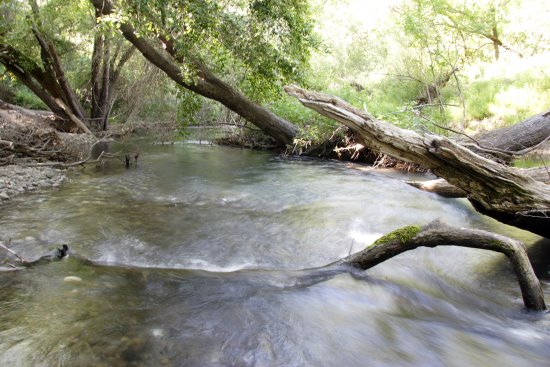
| ||||||
Back in the 1970s abundant red-legged frogs provided a cheerful chorus with the birds. It was my goal to inspire my students to imagine they were Native People from the past, hunting for nuts and berries, and gathering cattails and reeds for their homes along the creek. Each adventure included the importance of walking gently on the land.
Dozens of creeks flow throughout Lamorinda, and support hundreds of species of aquatic life. If you pause quietly along a stream, your sharp eyes may spy water striders and minnows hunting for water bugs and the larvae of damselflies. For your creek walk, wear boots and bring a small white plastic bowl and plastic cup for gently scooping water along the base of water plants. A small magnifying lens will help you see the small water animal.
You may have found feathers while walking the local trails. These are clues to the birds that are watching you. A soft downy feather must have fallen from a bird's chest, and the color is a clue - yellow could be a goldfinch or warbler; red could be a robin or spotted towhee. If the feather is long and narrow it could be from a wing. An owl's wing feathers have soft tiny hairs along the edges to muffle the sound of their nightly flights after mice.
After a nature hike, I like to gather everyone together to share observations. Native cultures used what I call a "Talking Stick" to give each person time to express ideas. This carved and decorated Talking Stick gets passed from person to person around the circle to honor the participation of all. You can decorate your own sturdy staff and use it at family gatherings to encourage everyone to share.
I have found that children are very passionate about the Nature Area. Over decades, thousands of parents have supported the outdoor environmental education programs in the Orinda Nature Area, because they value the hands-on sensory learning that enlivens their children and deepens understanding of science and history. Many people have told me that their children benefit from open spaces with the trees, water and grasslands. Scientists, citizens, and governments are urging the protection of 30% of land resources and 30% of ocean resources to ensure that plants, animals and ecosystems are sustained. Members of the United Nations, including the United States, are beginning to implement this conservation guideline.
The Orinda Nature Area, owned by the Orinda Union School District, is an 18-acre wild space has been promoted for many years by the Friends of the Wagner Ranch Nature Area; the Friends was renamed this fall as Friends of the Orinda Nature Area, so as not to be confused with Wagner Ranch School. The Friends, a grass roots non-profit that formed in 2005 to prevent construction of a maintenance yard, stepped up again in 2009 to fund education programs when the Orinda Union School District, due to funding limitations, was unable to continue its support. Since then, The Friends has received substantial donations from the community for the Naturalist, Nature Aides, and materials needed to conduct environmental education. For information, visit www.fwrna.org.
Reach the reporter at:
